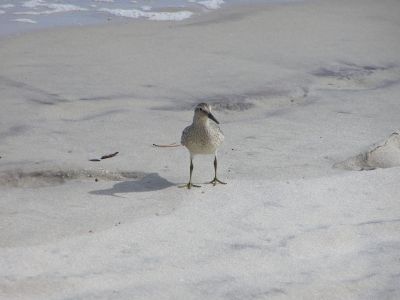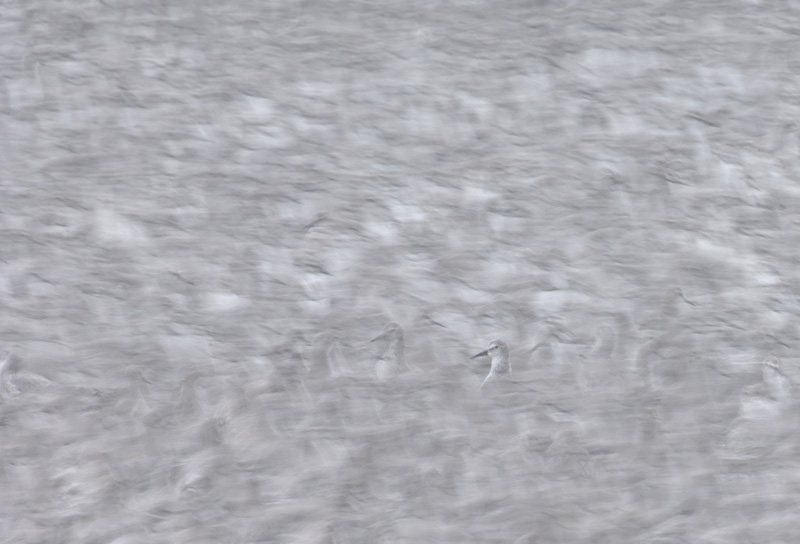
There were around 200 of us wrapped up against the cold – which never arrived as it was a mild and completely wind-less morning – and with our binoculars, telescopes and cameras, heading to the sea wall and then along to the southern end of the pits to look out across the vastness of The Wash. Looking west across The Wash the grey of the incoming tide merged with the grey of the sky. The mudflats to our left were dotted with birds in some places – curlews, redshanks and the occasional grey plover – and crowded with birds in others – massed ranks of knot, oystercatcher and bar-tailed godwits.
This was a day of flocks. There were a few desultory groups of starlings heading away from their night-time roosts but they weren’t going to be the stars of the show this morning; skeins of pink-footed geese moved inland from their roosts and called down to us as they travelled to feed on harvested sugar beet fields; birdwatchers milled around talking and chatting about the scene unfolding in front of them.
We knew, or at least we hoped we knew, what was about to happen. As the tide moved left covering more and more of the mudflats the waders would be pushed into a smaller and smaller area and then eventually they would lift off in their thousands and fly over our heads to sit out the top of the tide on the banks and islands in the pits behind us.
The knots were to be the stars of the show. A large flock, thousands strong, flew in from the right as their earlier roosting spot was inundated by the slow-moving but inexorable tide. The flock was dense but strung out over a large area as the birds flew in a long stream in perfect coordination to join thousands more of their species on the mudflats. Individually these are, at this time of year at least, grey birds. Grey on top and grey underneath, and when they fly they show their grey wings with a grey wing-bar. Maybe there were 50,000 shades of grey out there with a few black-and-white oystercatchers too.

Watching the knot in the distance it looked impossible to fit any more into their dense flocks but that was nonsense as occasionally hundreds more would join the birds on the mudflats. The rising waters ate up the mudflats and the flock moved, as one; thousands of individuals walking a few paces at a time looked like a solid grey sheet moving smoothly across the darker mud.
The knot were showmen. They bided their time and we waited for the show. Large flocks of oystercatchers were already pouring into the pits with occasional dunlin, redshank, barwits – and some knot mixed in with them too. It was so still that the sound of wader calls and the beating of thousands of wings were the loudest noises.
The flock of birdwatchers was not as numerous as that of the knot. We were 200 shades of mostly green (green wellies, green jackets, green jumpers) and I wondered whether we all looked the same to the knot. An expert knot would have noticed, as he or she flew over us that there were all ages of birdwatcher from about four years to certainly into the seventies. There were experts and beginners, expensive optics and some who had come without binoculars. We were a bit of a straggly flock and I gathered that our flock had members from all over East Anglia (down to Essex and Cambridgeshire as well as Norfolk and Suffolk) but also from Northants (that was me), Gloucestershire and even north Wales. We had flocked here with different amounts of knowledge and different expectations of the morning but we were waiting for lift off.
And then the knot start to come in their numbers – right over our heads in their thousands and thousands. As the masses lifted off from the mudflats we could hear their wings and see a grey cloud rise into the air. For about ten minutes the air was full of waders – mostly knot. There were many flocks, some of hundreds but some of thousands of birds in the air at once. Some headed over our heads and straight from the mudflats into the shelter of the pits. Even these birds did a bit of wheeling around as they swooped down into the pits and then rose and swirled before some more swooping and settling to roost.
Other flocks put on a fantastic show. Some headed out over The Wash and banked and flashed dark and light, but mostly grey, in perfect coordination. We didn’t know which way to look as there were flocks wheeling and performing behind us, in front, to the left and right and above our heads. It was an amazing natural show and we ‘ooohed’ and ‘ahhhed’ as the birds performed as they have done for thousands of years at this stage on their cycle of tropics-Arctic migration.

There were still waders on the mudflats and some gradually added their numbers to the birds in their crowded roost but the peak of the show was over now. We talked with pleasure of how amazing it was and there were lots of smiles all round. Our flock now became a rabble. Some went to the hides to get a closer look at the roosting birds, some continued to look out at the mudflats, some thoughts began to turn to breakfast or maybe even getting back to work.
I took a quick look at the ranks of waders roosting on the bank of the pits. There was a black mass of oystercatchers divided by a thin bright green strip of vegetation next to a grey track- except on closer looking, the grey track was the knot in their masses.
Heading back to the car park, my mind was full of flocks, although there had been a few individual highlights too. A single bonxie had been sitting out on the water and a single swallow flew south which most people appeared to have missed. And then there was the slightly odd sight of a single immature gannet flying inland towards Sandringham. A single avocet looked ill and miserable near the edge of the mud. And there was the young (ish) single lady from Essex whom I remembered seeing at RSPB events in the past who was having a birding break in Norfolk.
But the flocks were what the day was all about.
Your next chance to see this spectacle at dawn (when the geese fly out of their roosts) and with a suitably high tide is on 17 November at 0635 – it’ll be colder that day but the spectacle will fill you with a warm feeling. I still have my warm feeling – knot!
[registration_form]
A wonderful spectacle to see and a reminder of how important our coastline is for migratory shorebirds. It is a precious thing we should all cherish and a very good reason why we should be very resistant to politicians’ seductive promises of ‘Boris Islands’ and tidal barrages and such like that could result in our gandchildren never having the chance to see such fabulous natural spectacles.
Off-topic
11.00am today on the wireless – Radio 4 Saving species Raptors
http://www.bbc.co.uk/programmes/b01ng7rw
And you should hear me on the programme – recorded yesterday.
Thanks Filbert,
Very interesting, particularly the views of the great Dick Potts. I’ve yet to reach the ‘Living with Raptors’ chapter of his fascinating book.
Quotas? No thanks. The phrase ‘thin end of the wedge’, springs to mind. A quota system designed to regulate the number of gamekeepers would be more pallatable.
Lets not spoil the moment by moving and staying off topic.
Today’s blog is again a well written piece about a wildlife spectacle which makes me at least, consider in greater depth just why I’m interested in birds and what they do, and why they are so fascinating.
Just a day holding the joy and wonder of such sights in mind, without having to think about the huntin’, shootin’ brigade and their luddite views please?
Great blog Mark.
I was there myself Friday morning and would have said Hi if I’d seen you.
It was a wonderful experience and well worth the 3.30am departure from Hertfordshire.
I took a bit of video which can be seen here – http://www.youtube.com/watch?v=CkCHro24bek&feature=g-upl
17th November is in the diary to do it all again
BTW, did you see the Great Skua that flew up the beach at about 10.30?
Best wishes
Mark
Mark – great! Have added a link to your video to the blog.
Nice one Mark, I have been there in the evening for the fantastic sight of the geese going back out to the Wash but have not had the sightings of Knot like this.
One of my favorite posts so far Mark, a great spectacle, the Chris Gommesal image is one of my all time favourite images. One of the best rumours I ever heard at Snett’s was that Prince Phillip ofen visits, not sure on that one though Also glad to hear that someone under the age of 18 was there so early to watch.
Also glad to hear that someone under the age of 18 was there so early to watch.
Lovely blog Mark. Thanks.
But I wouldn’t envisage seeing anything at all at 0635 on the 17th November. It will be still dark at that time in mid November?
You suggested you may write about badgers this week. Tomorrow would be a good day after todays news?
Doug – I think you’ll find that is the time to get to the car park for the walk to the hides. Badgers on Thursday.
Gotcha. Thanks.
There is also a story about a past RSPB warden at Snettisham who on spotting an elderly lady with a couple of small dogs shouted at her to ‘keep her f*****g dogs on a lead’ and then on seeing who it was added ‘please ma’am’ to the end.
Rob – I’ve heard that story, it’s a good story, But I’ve always wondered if it were true…